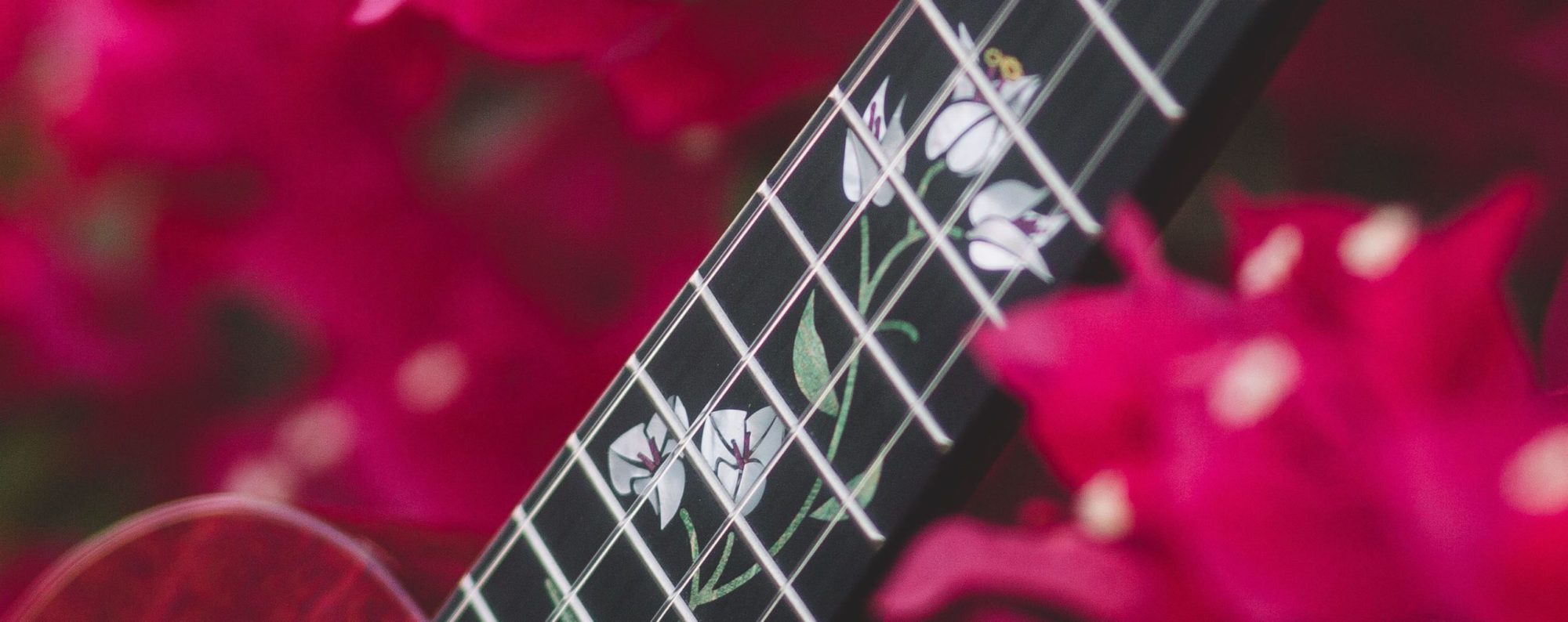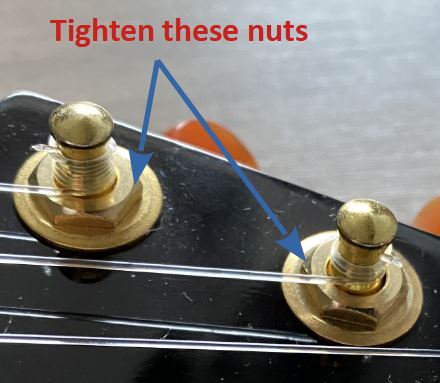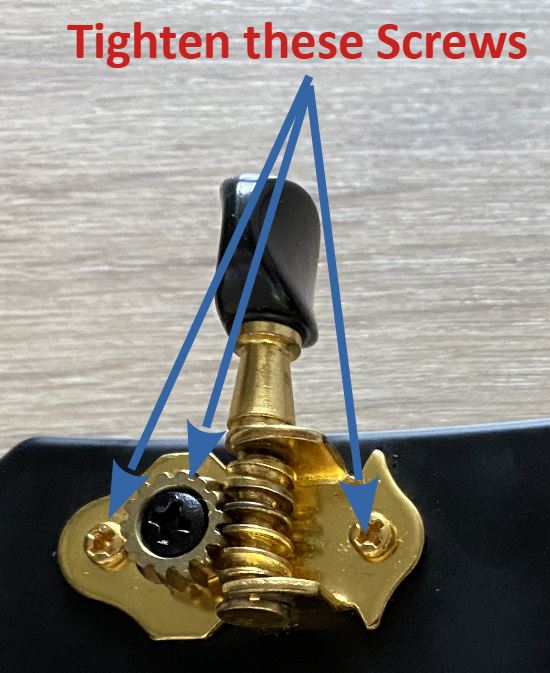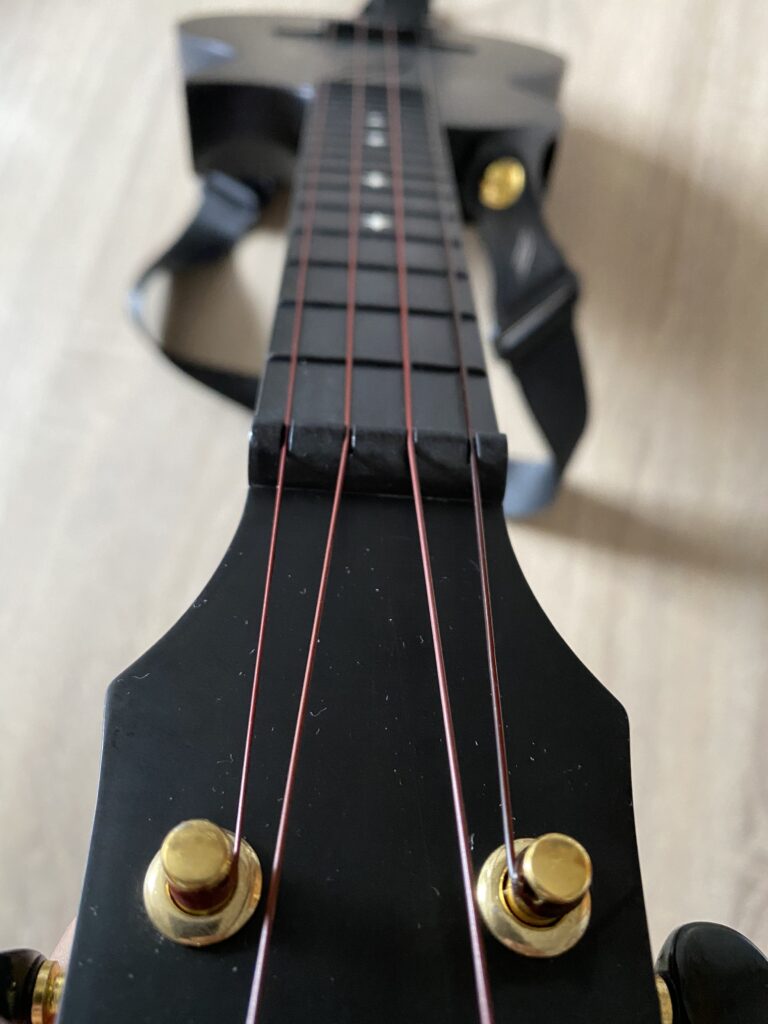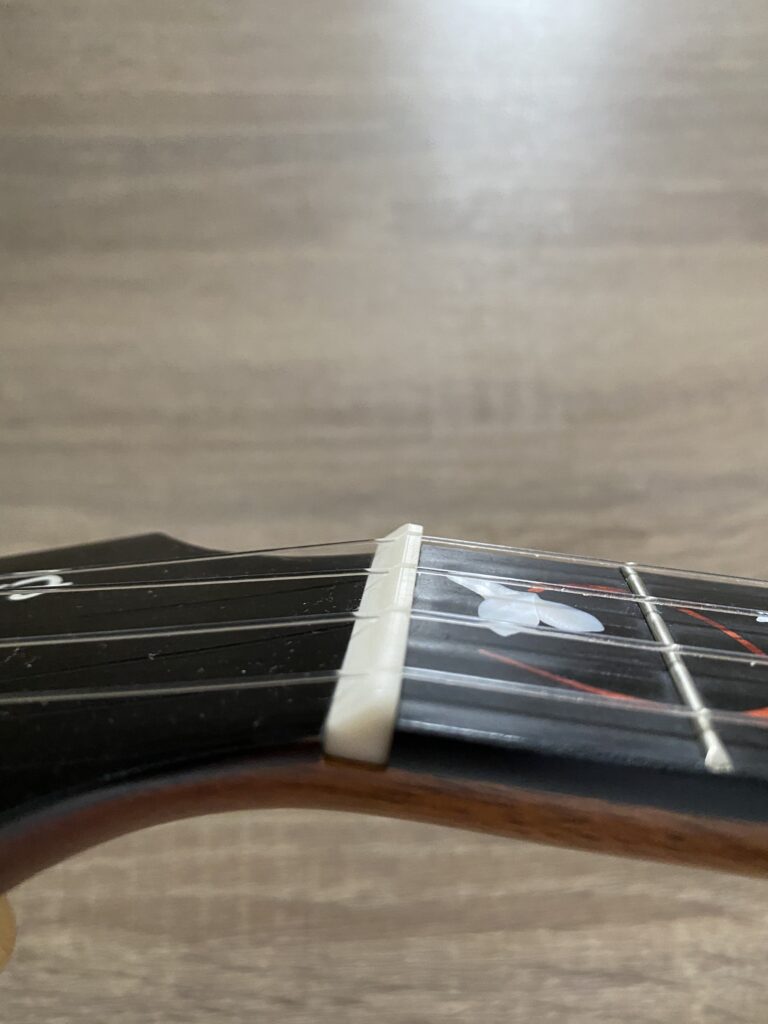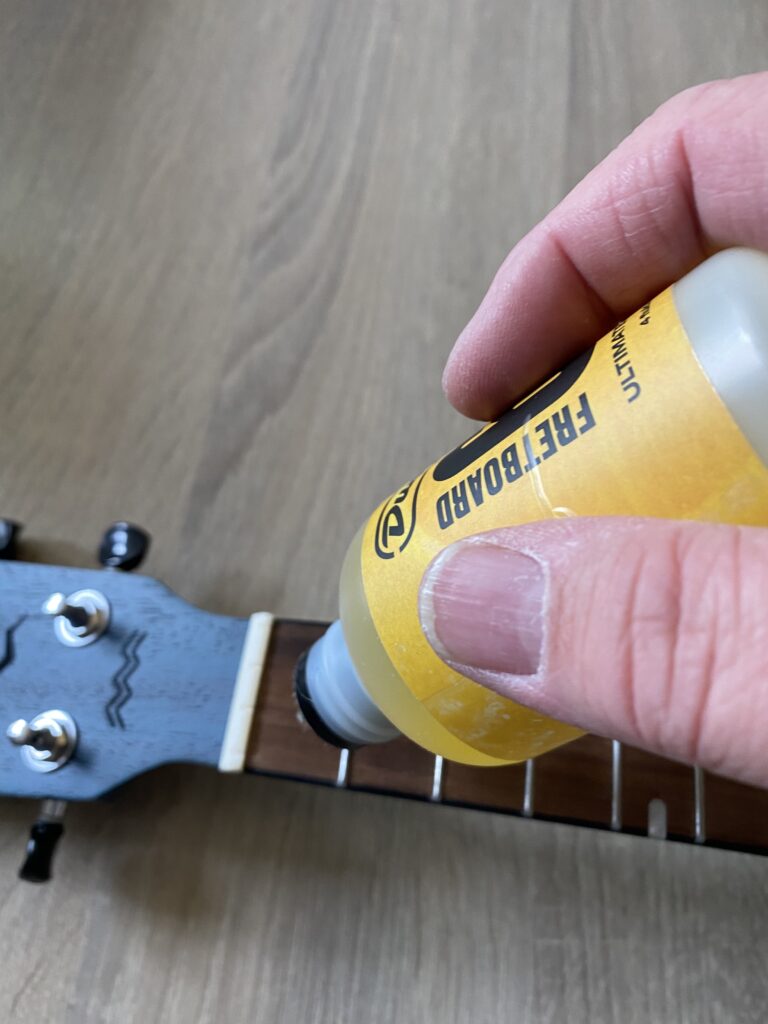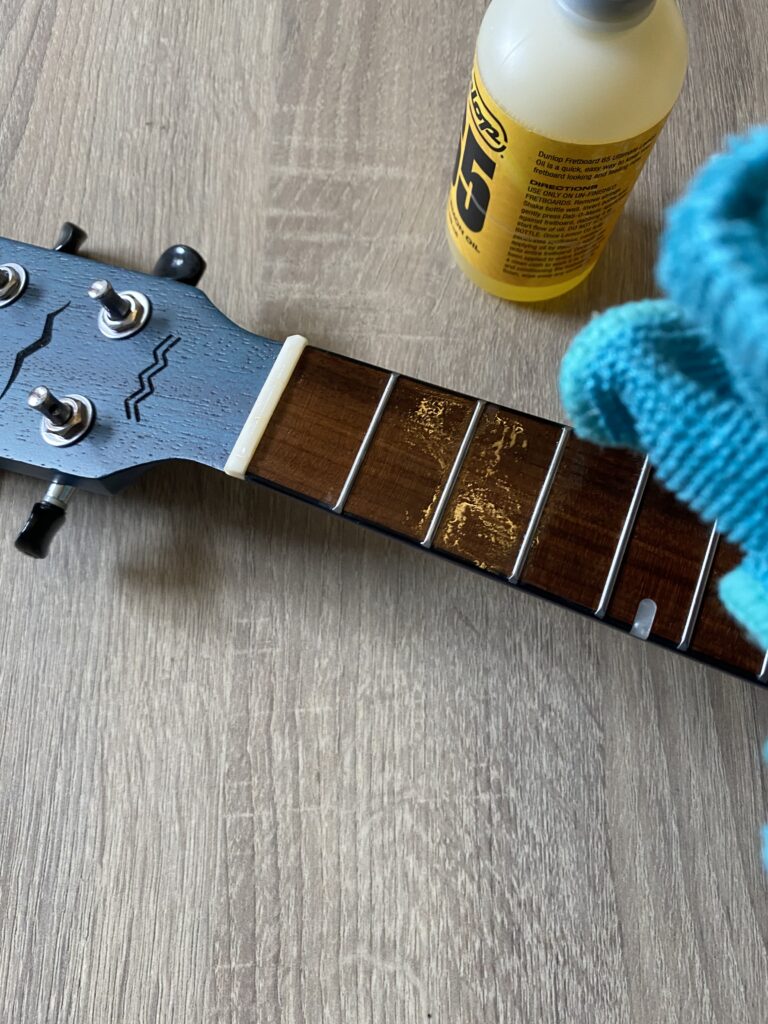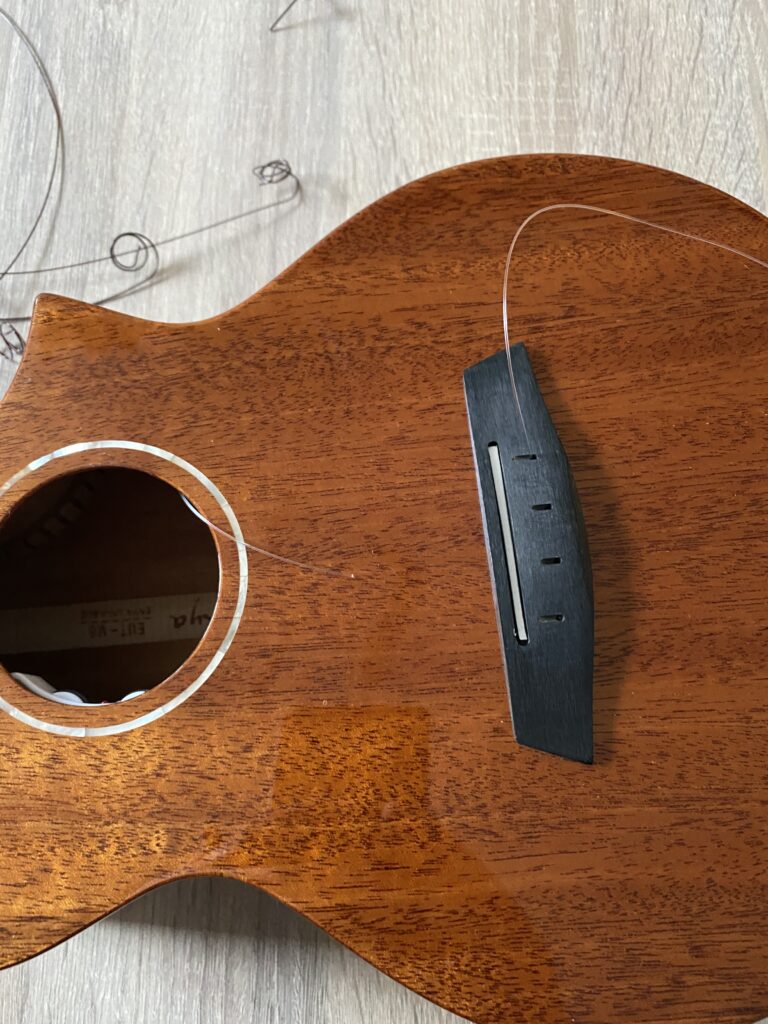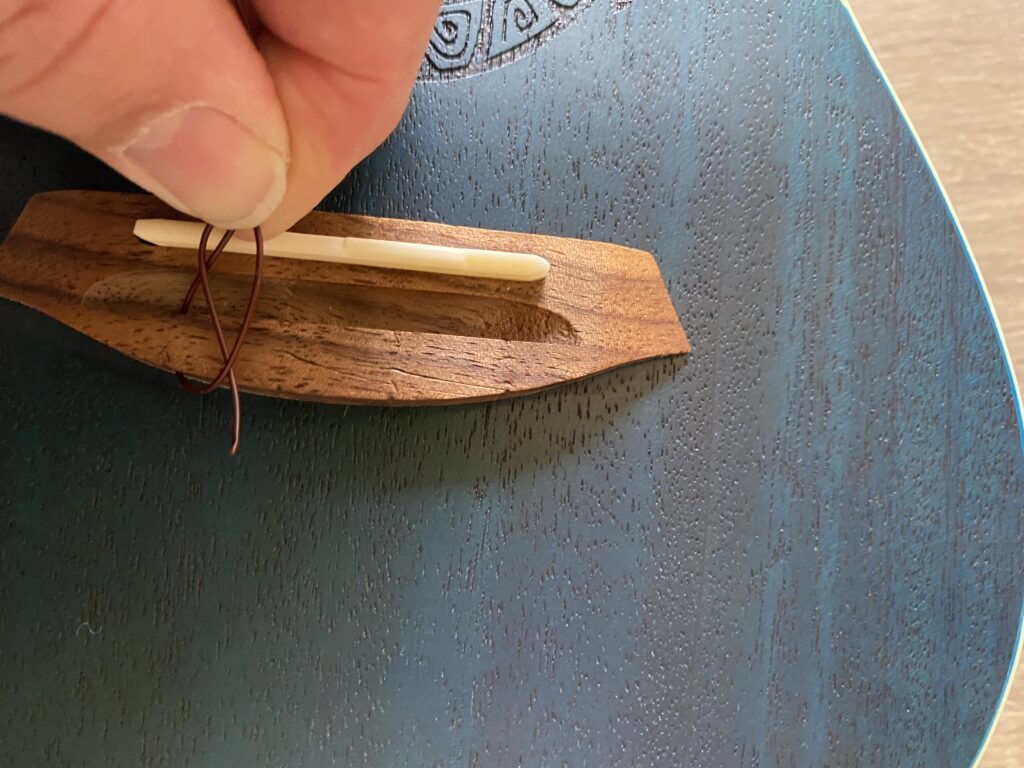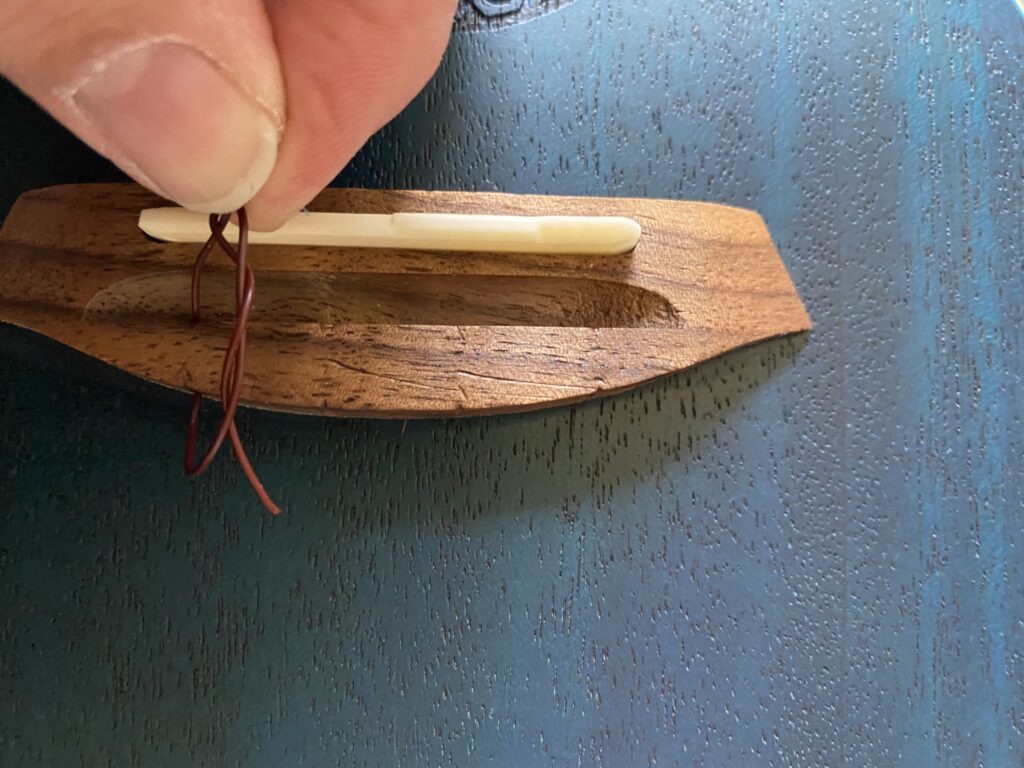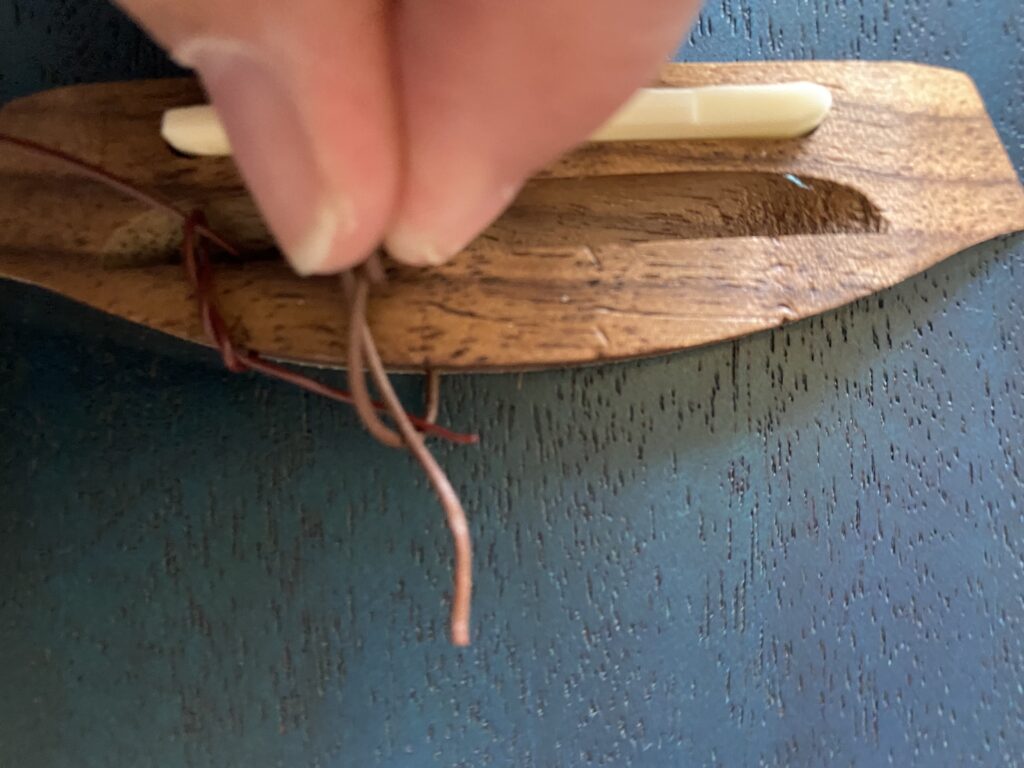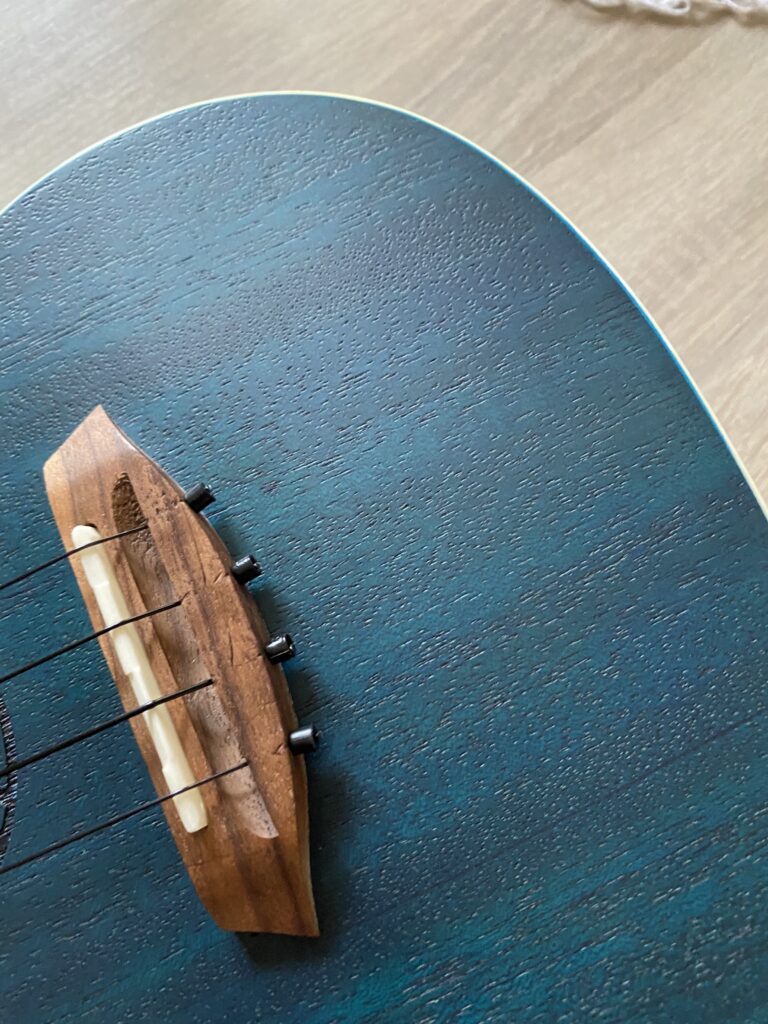Here is our 6th issue of the Ukelandia Magazin
5th issue of the Ukelandia Magazine now online !
Here is the 5th issue of our magazine.
What’s all that Buzz ?
by Stefan Harder
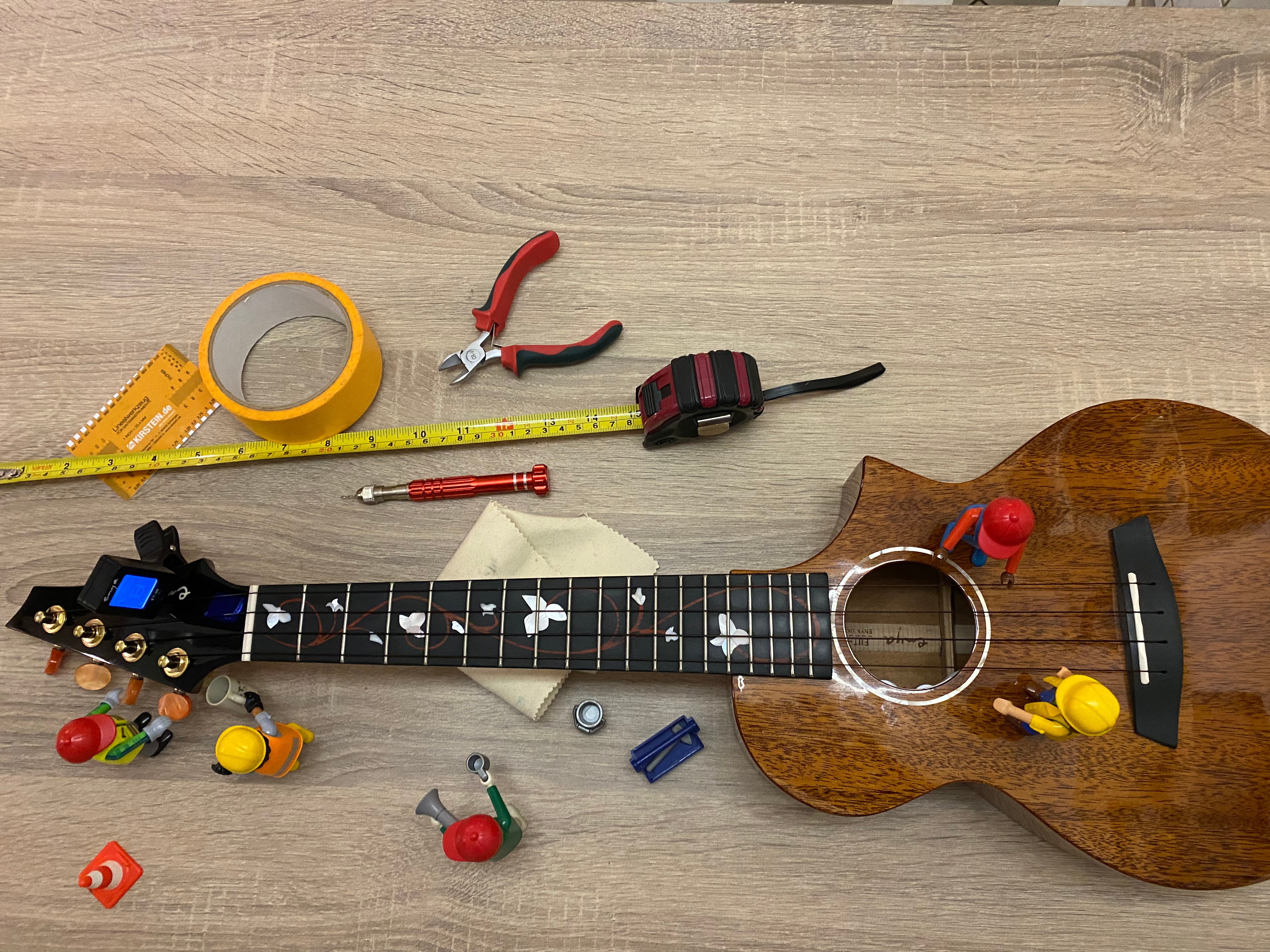
We all know that moment: We play a song on our Ukulele and one of our strings makes a buzzing sound, instead of the desired note. This article will help you to find the reason for that buzz and will show you a way to fix it.
But first we examine our ukulele for reasons, please ask yourself this:
Was it me who made the uke buzz ?
I’m not kidding. Often a string buzzes, when it is not properly fretted.
Make sure your fingers are as close as possible to the fret wires, when you hold a chord or a note.
Ensure that you use the right amount of pressure on the strings, to press them on the fretboard. If you press too lightly, the string may vibrate uncontrollably and cause a buzz.
Do not press too hard either, as that may hurt your fingers.
Don’t let your fingers touch strings that shouldn’t be touched. (This often happens with three finger or barred chords.)
- Make sure your fingers are as close as possible to the fret wires, when you hold a chord or a note.
- Enyure that you use the right amount of pressure on the strings, to press them on the fretboard.
- If you press too lightly, the string may vibrate uncontollably and cause a buzz. Do not press too hard either, as that may hurt your fingers.
- Don’t let your fingers touch strings that should not be touched. (This often happens with three finger or barred chords).
Looking at the action
Working our way down the Ukulele, we will check some things on the fretboard and neck. When your strings are buzzing along the fretboard, the height of your strings (aka the action) might be too low.

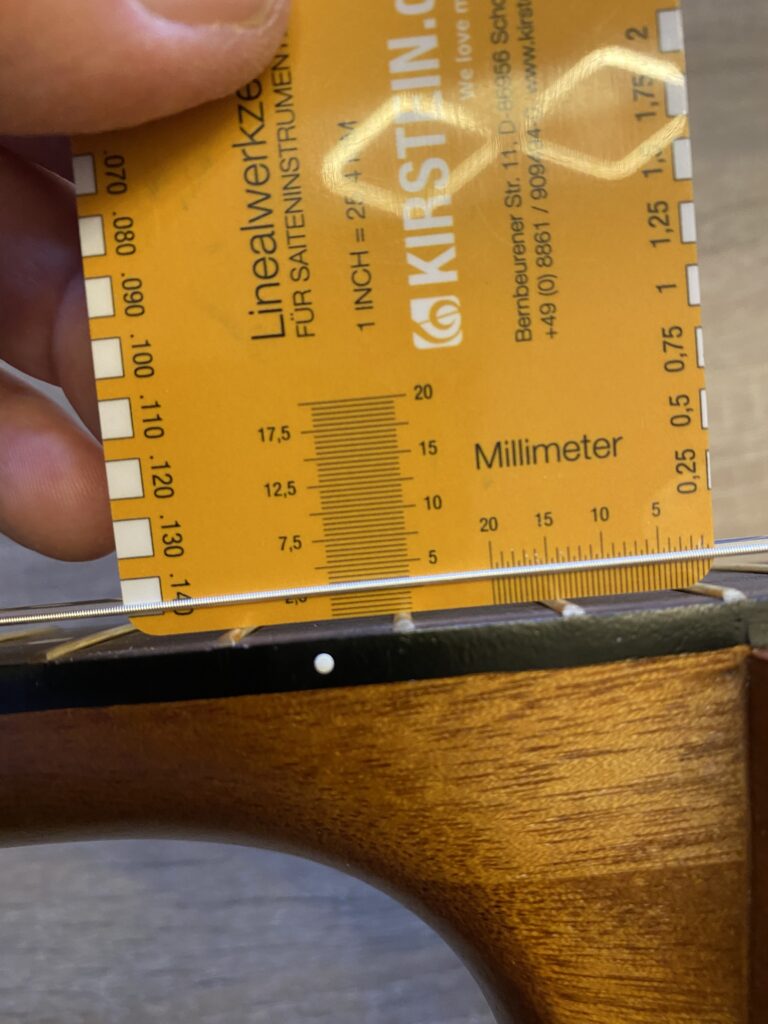
It could be measured with a (string) ruler at the twelfth fret, cause this is the center of the scale, the middle point between the nut and the saddle. If it is lower than approximately
1 millimeter, the action is too low. A value of more than 2.5 millimeters might indicate too high an action, especially if you find playing barre chords up the fret as uneasy.
Humidity
Also the main cause of those issues may lie in the humidity of the location of where the uke is stored, because the neck may bow or back bow.


Humidity is best between 45% to 55% and a temperature level between 20 to 25 degrees Celsius (68-77 OF). Short time of higher or lower humidity or temperature shouldn’t harm your instrument, but constant deviations surely will. Again, look at our 3rd issue of the Ukelandia Magazine (https://ukelandiamagazine.com/here-are-the-issues-of-our-magazine/), where we have an article about ukulele and humidity.
Body of the Ukulele
If you still hear a rattling sound, when you shake your ukulele, take a look inside the body (use a flashlight and a mirror or the camera of a mobile device). It may be a loose cable from a pickup or other hardware that has to be fixed or tightened to stop the buzzing. Search the body for small cracks. If you find one, hold your finger on it and strum the Uke to check whether this crack is actually causing the buzzing. Anyway, take your uke to a luthier to get the cracks repaired.
If the buzzing stops, when you put pressure on the saddle or the bridge, then they are loose. This should be fixed by a luthier
How long have the strings been on the Ukulele ?
How long have they been on the Uke?
Have you ever changed them?
Is it time to change them ?
If you’re in doubt of it, lay your pinky under the a-string, right by the soundhole.
Then slide up to the neck. Repeat this of all strings. If you feel any notches on a string, it is time to change them all. If you haven’t done this before, take a look at our 3rd issue of the Ukelandia Magazine (https://ukelandiamagazine.com/here-are-the-issues-of-our-magazine/), where you will find guided instructions for changing strings.
The headstock
First step: Mute the strings on your instrument and then shake it. If you hear a rattling sound from headstock it is most likely that you have loose hardware on it.
Check if your tuning pegs are loose. If so, tighten their screws. Another issue may be that the gears could be worn and need to be replaced.
Depending on the type of tuners on your ukulele, you might have to tighten screws or nuts, like in the two examples. Be careful with that, “do not screw to tight” especially when you work on the visible side of your instrument.
If you haven’t already trimmed the excessive strings at the tuning pegs, do it now.
Checking the nut
Next we will look at the nut. If your ukulele doesn’t buzz, when you bar an entire fret, but you hear it, when you apply pressure to the strings between the tuning pegs and the nut, then the strings may vibrate inside the nut grooves. This often happens, after installation of a low G string, especially, when you previously had a high G string installed. It may also happen, when you install new strings that have a thicker diameter then the old ones. That is a task you local music store or luthier should handle.


It might be that your nut is too low. Try to fix this with a small strip of paper under the nut, otherwise let a luthier replace the nut.
Here are two examples of strings, running into the grooves of the nut, down to the tuning pegs. Notice, that the grooves are angled downwards to the tuning pegs, so the above ssues won’t occur here.
I hope this article has helped you in your challenge to conquer buzzing strings on your Ukulele. I would appreciate feedback on our website (https://ukelandiamagazine.com) or via email under stefan@ukelandiamagazine.com.
String theory – Or: How to change the strings on my Ukulele
by Stefan Harder

We all know that moment: It’s time to change the strings on the ukulele !
Some accept it and go to work, others fear this moment.
Let me tell you: Don’t fear, I will help you in your struggle and guide you through this. Read the following article and you will be brave enough to change the strings yourself and maybe you are able and willing to take some extra care of your ukulele.
When is the right moment to change the strings?
Obviously, when one of them breaks, you should change them all.
You can check your strings, when you run your little fingers on the back of the strings. If you can feel little notches from the fret wires, then it’s time to change the strings.
What will I cover in this article:
Of course, the process of changing the strings. We will also have a look at different kinds of bridges and I want to give some tips for cleaning and maintaining your Ukulele.
At this point, before you take the old strings off your Ukulele, you might want to take a look at the action (the height of the strings above the fretboard). For this part I refer to my corresponding article about “Lowering the action” in our 3rd issue of the Ukelandia Magazine (https://ukelandiamagazine.com/). This step is definitely optional and more than a basic task.
What do we need for our task ?
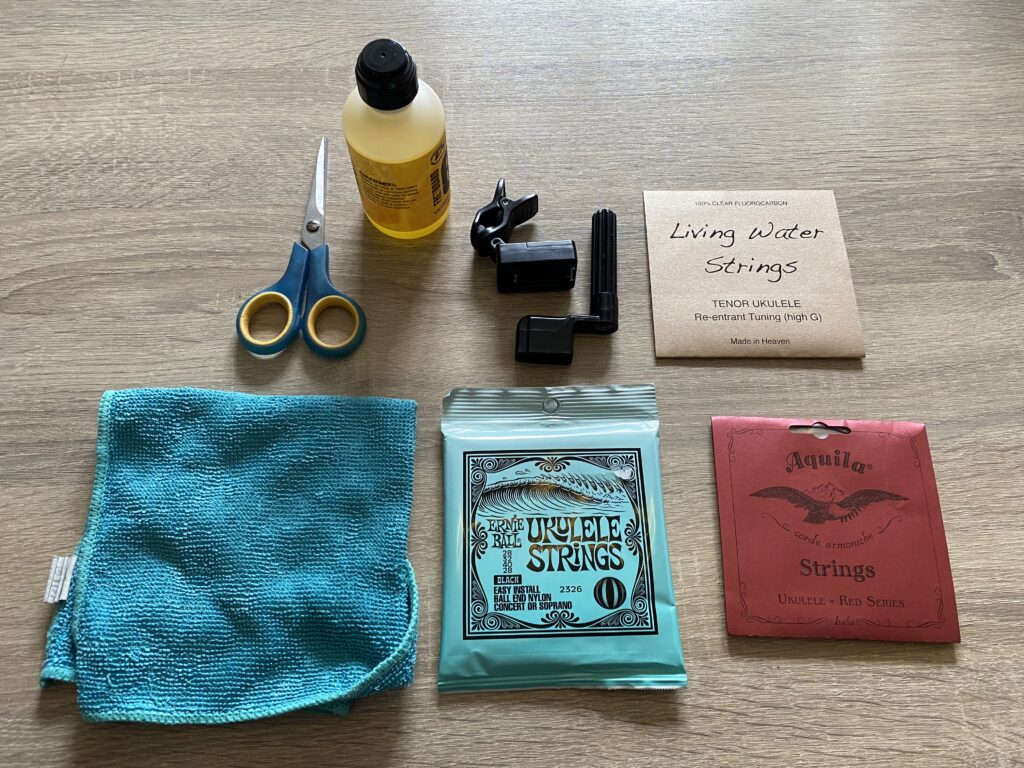
Strings, a tuner, a string winder (optional), cleaning cloth, fretboard oil, a scissor or a pincer.
We don’t have steel strings on the ukulele, but the strings are still under tension and I first loosen the strings a little so that I can take them out of the tuners.
Depending on the type of bridge on your instrument, you pull the strings out of the bridge, the ukulele itself or you cut the knot and the upper side of the bridge to remove the old strings. Let’s have a look after these different types of bridges:
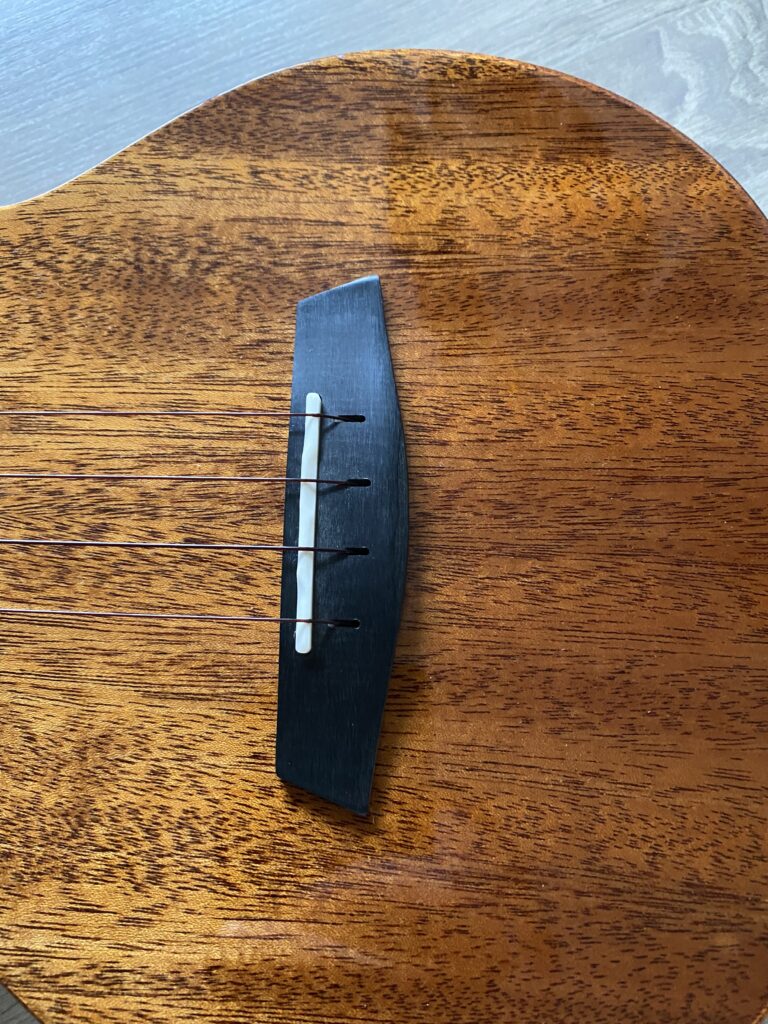
Bridge with pulled through strings
You have to pull the old strings through the sound hole out of the ukulele. Beware of the little rings or beads that are tied to them. You need them to attach the new strings!
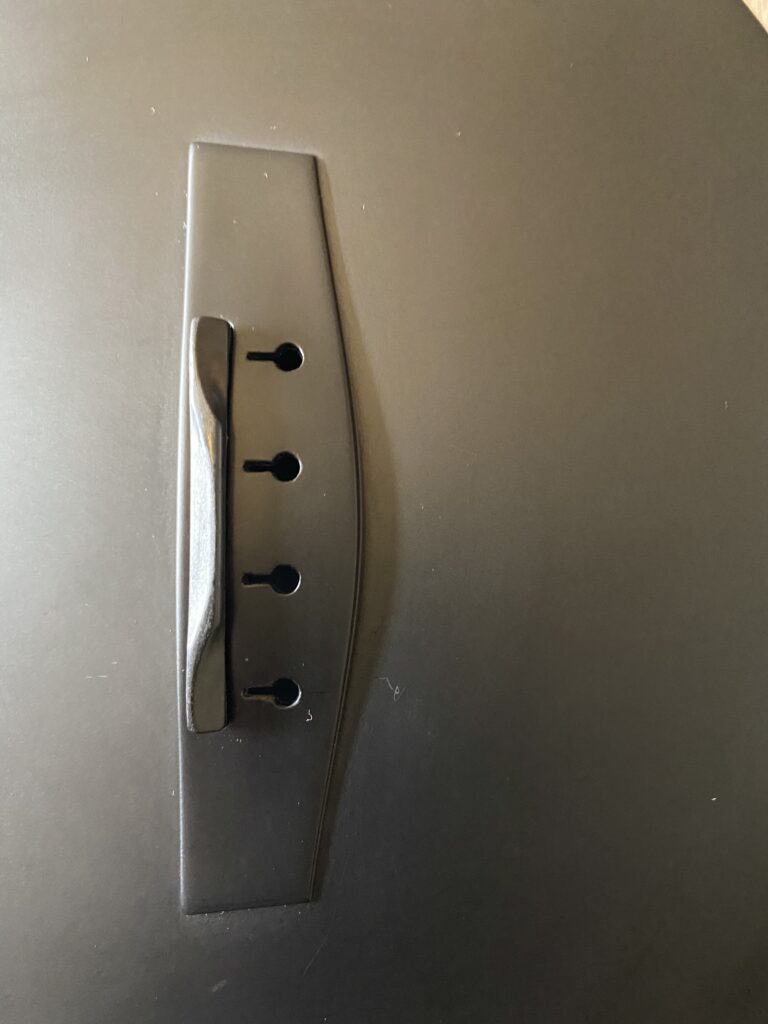
Bridge with hooked strings
Just pull the strings out of the holes.

Bridge with knotted strings
Cut the knot or untie the strings.
Caution: The saddle might fall out of your instrument, so it’s a good idea to take a picture of the alignment on the saddle, to reinstall it properly.
After getting rid of the old strings, we have the ability to clean the body and fretboard from stain and dust. I use a dry microfiber cleaning cloth to wipe over the whole instrument. Stubborn stains will be removed with a little moisture.
If you have a wooden fretboard you might want to add some fretboard oil to it, to preserve the wood from damage through dehydration. For that, just follow the instructions on your fretboard oil. I applied oil on the fretboard, until it was totally soaked and removed the excess oil with the cleaning cloth.
I also applied some of the oil to the wooden bridge on my uke, before I reinstalled the saddle.
If you have a ukulele that has a wooden body without any varnish on it, you could also apply a thin layer of oil on it. If your instrument has a layer of varnish on it or is made of plastic/fiber carbon, you can simply clean it with a damp cloth.
After cleaning we can install the new strings. The type/brand of strings you choose is totally up to you. If you were pleased with the ones that you removed, use the same type of strings again. On the other hand, there are numerous discussions on the internet about different strings, sharing the advantages or disadvantages of particular strings from different brands.
For my three instruments I used different strings from different manufacturers.
For my Enya Nova I used Aquila Reds with an unwound low G. For a plastic or fibre carbon fretboard you shouldn’t use wounded strings, because they could damage the fret wires or the fretboard. On wooden fretboards with metal fret wires they won’t cause damage. My Flight DUC380 CEQ received Ernie Ball nylon strings with a ball ending. The Enya EUT-M6 got Living Water fluorocarbon strings. Make sure you buy the right size of strings for your instrument, to fit properly. (e.g.If you have a Tenor , you don’t want to mistakenly buy strings for a Soprano)
Let’s have a look at the different bridges:
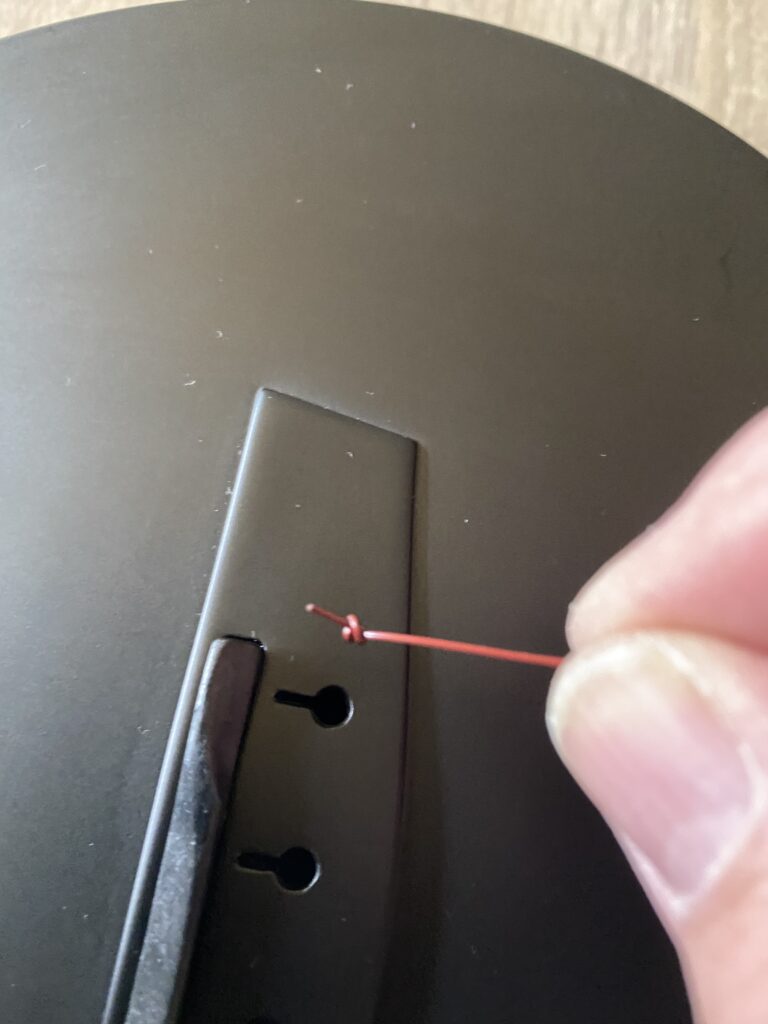
At first the Enya Nova with it’s slotted bridge
I tied a knot at the end of the strings,
making sure, that the end is about
2 mm long, so that it wouldn’t cause
buzzes inside the instrument, then I
hooked it under the slot and pulled it
to the tuners.
Second we will look at the Enya M6 with a pull through bridge.
I pass the string through the hole and pulled it out of the soundhole.
Next I tied the little bead, that was on the old strings to it,
Again, making sure to keep the end of the string short.
Then I pulled the string to the tuner.
At last we look at the “standard bridge“ on my Flight DUC 380 CEQ.
After reinstalling the saddle I passed it through the hole of the bridge. Now, there is a bit of knotting needed.
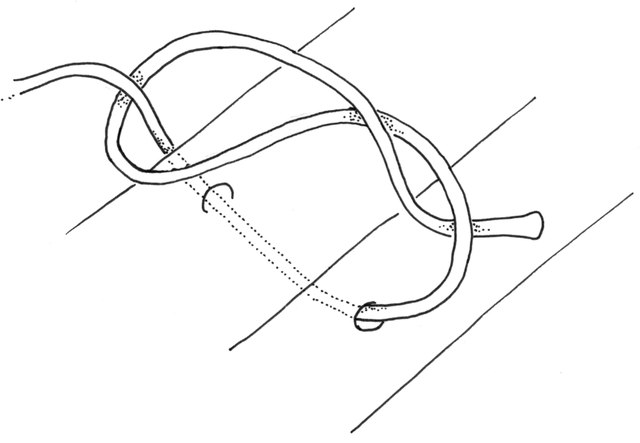
(Picture by Mike Dickinson, commons.wikimedia.org) 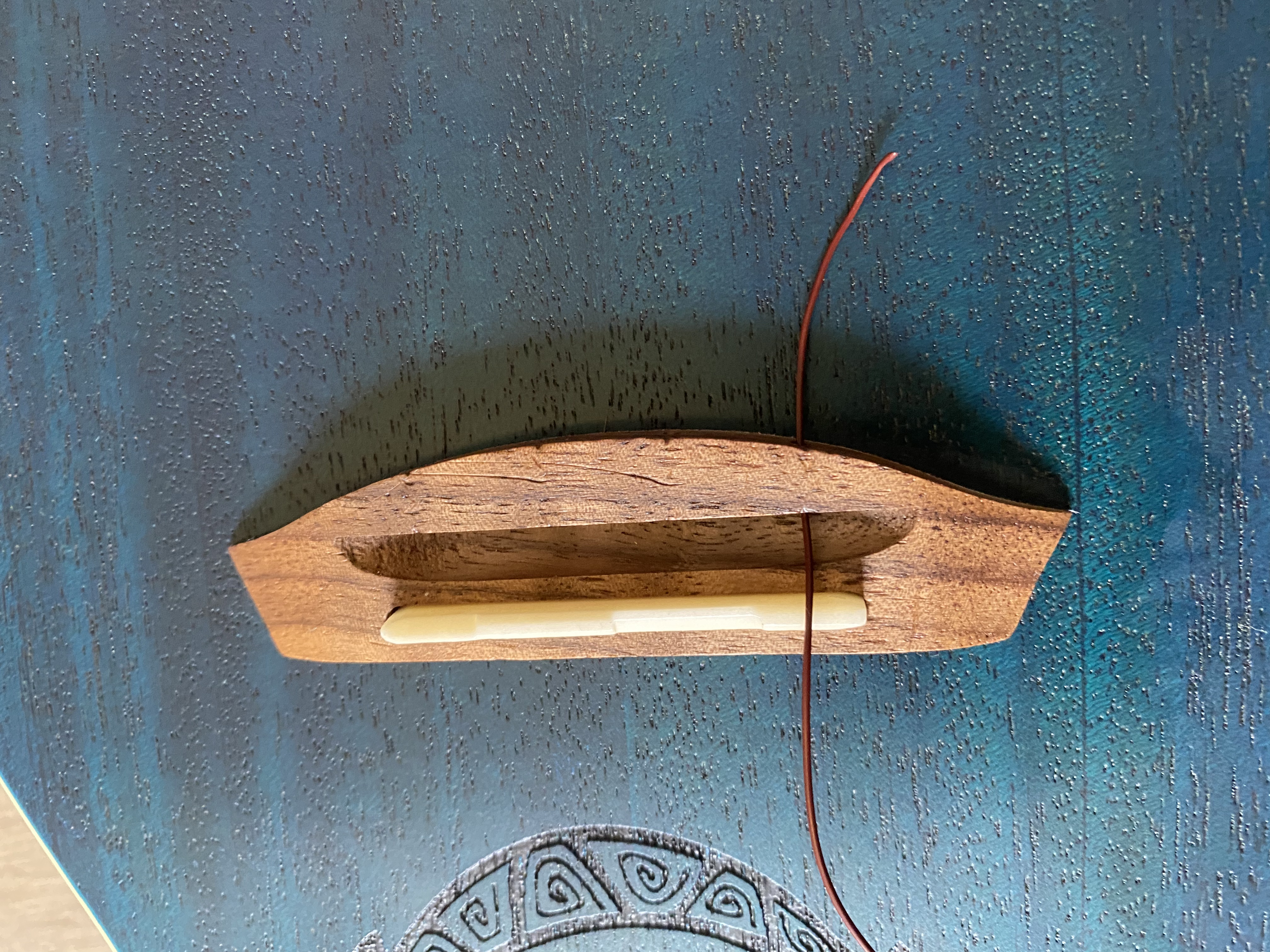
You’ll need to loop the string back around itself and tuck the end under and tighten it. I tuck the end of the string into the next knot, so that it wouldn’t hang loose at the bridge.
I used the mentioned Ernie Ball strings, just to try them out and have easy mounting of the strings, since the balls at the end do not need knots.
Having the installation on the bridge covered, we will look at the other side of the strings and how to fasten them on the tuners.

I lead the string through the notches on the nut, push them through the little hole on the tuning peg and pull them tight. After that, I turn the peg counter-clockwise to fasten the
strings on the tuner. The turning direction is up to you, you could also turn them clockwise if you like.
I try not to wind up too much string,
because the more string you wind up,
the more they have to stretch, until the strings settle. I cut the excess string short (approx. 2 millimeters) on the tuners
Repeat this with all 4 strings, tune them and you’re done.
Congratulations !
You just changed the strings on your instrument yourself.
As mentioned, the new strings have to stretch and settle in the next few days. Play your instrument daily for about 15 to 30 Minutes, stretch the new strings by pulling them out and they normally will settle in about seven days. You could tune them a half step higher after playing, that might accelerate the process of setting a bit.
Community Artist – Karl Jackson
by Dave Thorpe
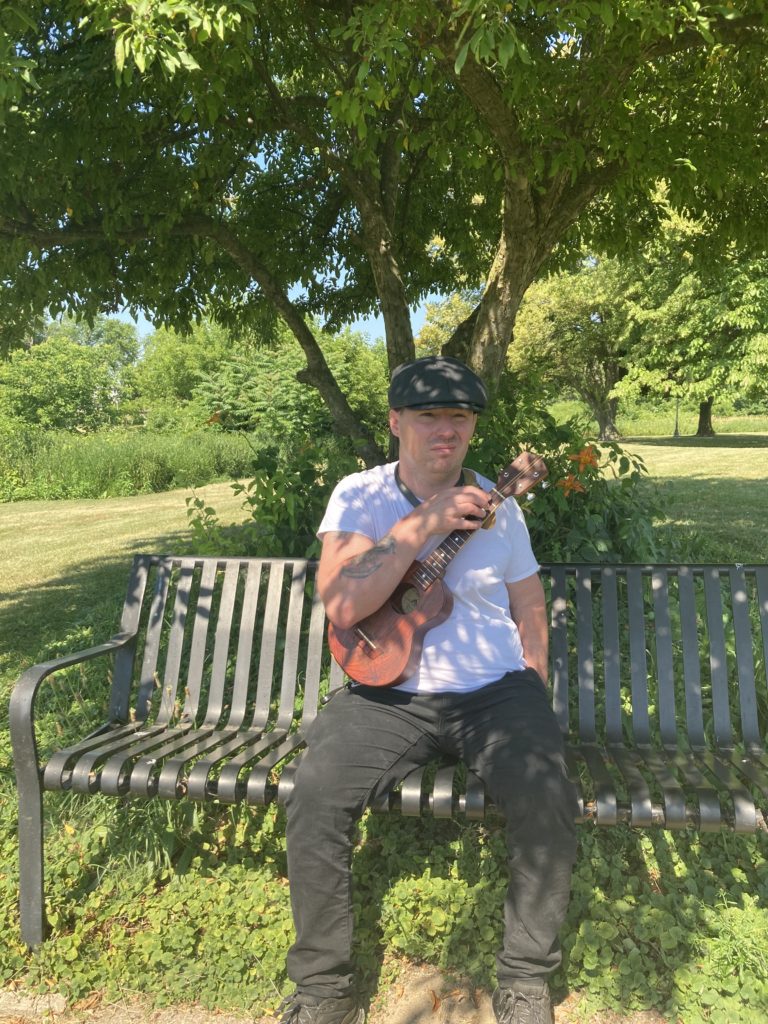
Any regular Ukelandia Facebook followers cannot fail to have been intrigued, impressed and inspired by the playing of our own Karl Jackson. Karl has been a member of Ukelandia since December 2021 and is a regular, and valued poster of videos. Karl has a unique personally developed playing style necessitated by the fact that he has one arm. In this interview I discuss with him his ukuleles, the development of his playing and his ambitions.
Hi Karl – an obvious starter – what got you into playing ukulele and how did you come across the Ukelandia community?
I first took an interest in the ukulele after my youngest daughter said she wanted to learn to play in 2019. Helping her get started watching tutorials online made me realize that I wanted to learn as well, though I had been told by music instructors in the past that playing more than hammer-ons on a stringed instrument would be impossible.
What scale lengths do you use (soprano/concert/tenor/baritone) – are some more suited to your style than others?
My preferred scale length is concert, though I can play any of the differing sizes of ukulele. I found that the concert size fits best for my playing style as it best matched the length of my forearm. The longer scales require me to reach for the first few frets, that’s why I play the longer scales with the ukulele resting on my lap still.
Obviously, you have to do the job of two hands – strumming and fretting the notes – with one. For anyone who has not seen you play can you describe the mechanics of what you do?
To learn to play I had to train my fingers to do specific jobs on the fret board. I started with my ukulele lying on my lap face up like a dulcimer or lap steel guitar, fretting one string at a time with my index finger and picking the string with my pinky. As I built up the muscles needed to do this, I was able to start using my middle and ring fingers for fretting as well. So, my pinky is in essence doing the work of my strumming hand, and the other three fingers are doing all the fretwork. My thumb is usually supporting the back of the neck to keep the ukulele from moving around too much, that or I use it to pluck the open G string.
Those of us that follow you on FB have watched you develop as a player. We’ve seen you move from playing melody only to playing chords as well, and from playing the uke horizontally while sitting down to playing standing up. What do you consider to be the major developments in your style and what has driven those developments?
Every day I learn something new about the ukulele, my playing style, and the impact sharing my playing style has on others. The most recent developments in my play style have been learning to play with the ukulele strapped up off my lap, singing along to my own strumming, and playing my harmonica and the uke simultaneously.
One of the biggest drivers in these developments has been my increasing confidence in my abilities.
Sharing my videos on Facebook (Ukelandia especially), lead to an outpouring of support from the ukulele community. The support and encouragement that I saw, made me honestly appraise my playing style, not for the one-handed aspect, but for the actual music I was making.
Away from the uke and playing, what is the music you listen to – are there particular musicians (uke or otherwise) that you admire?
I am a big fan of the blues, jazz, and especially ragtime music, which reflects itself in the music I play on ukulele. Some of my favourite past artists include Tom Lehrer, Robert Johnson, Frank Sinatra, and Larry Addler.
I am often enjoying the styling of Keb Mo, Thomas Benjamin Wild Esq, and Hugh Laurie, just to name a few.
You have come a long way since you joined us in 2021, what’s next?
Moving forward, the ukulele is becoming a predominant part of my life goals. I am working with music therapy groups out of New York and Hawaii to get established doing workshops at events and to help inspire others.
Additionally, I am working on a one-handed ukulele primer, so that others with limitations can break out of the “That’s Impossible” mindset.
Beyond that, I am excited to see where my ukulele takes me next!
Karl, many thanks for your time here and telling us about your musical journey. It’s been fascinating to hear your story. Thanks also for all your inspiring videos. I look forward to many more!!
Learner to Luthier
by Peter Bos
The Ukelandia Facebook and Telegram groups have conversations about new and special ukuleles which is always a fruitful topic. Next to the well known Ukulele brands there is a market for custom ukuleles. These ukuleles are created by luthiers.
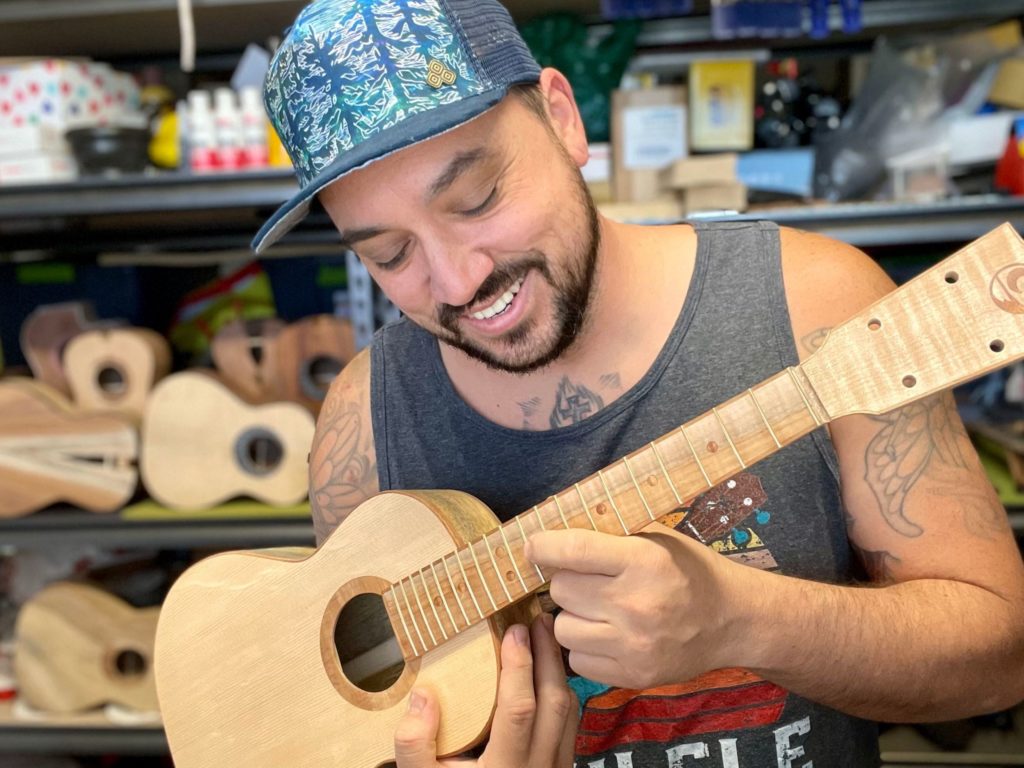
Whilst creating the Ukelandia Magazine, I came in contact with luthier, Kawai Carvalho from Coast Ukuleles. He is a very kind human being and he shared his emotional and heartwarming story of how he became a luthier with me.
Kawai was born in Hawaii, but left the Islands when he was 18 years old. He grew up around ukulele music, but he didn’t really catch the uke virus growing up. This didn’t happen until he and his partner EB had their first child and went to Hawaii for a vacation. During the holiday, he bought a Makala and fell in love with this instrument. It connected him to his Portuguese heritage and his roots back to the Island.
He brought the Makala back to California and UAS quickly struck Kawai, as his uke family expanded while he was still learning how to play it. He went to meet-ups and met a lot of native Hawaiian people who used the ukulele as a gateway back to their heritage. After acquiring about six ukuleles, Kawai became interested in a custom ukulele.
The 2020 pandemic gave him more time to get acquainted with building a custom ukulele for his collection. Custom ukuleles are priced high and as a true uke DIY’er, he decided on a simple ‘build your own’ uke kit, which has a lot of pre-made materials. Constructing this ukulele inspired him to make more. He started building his custom ukulele in his large garage only this time from scratch. I couldn’t imagine where to begin building a uke, but Kawai told me there is a lot of information online. Especially the “Ukulele Underground” which is a very supportive and helpful community with a lot of guides and approachable luthiers.
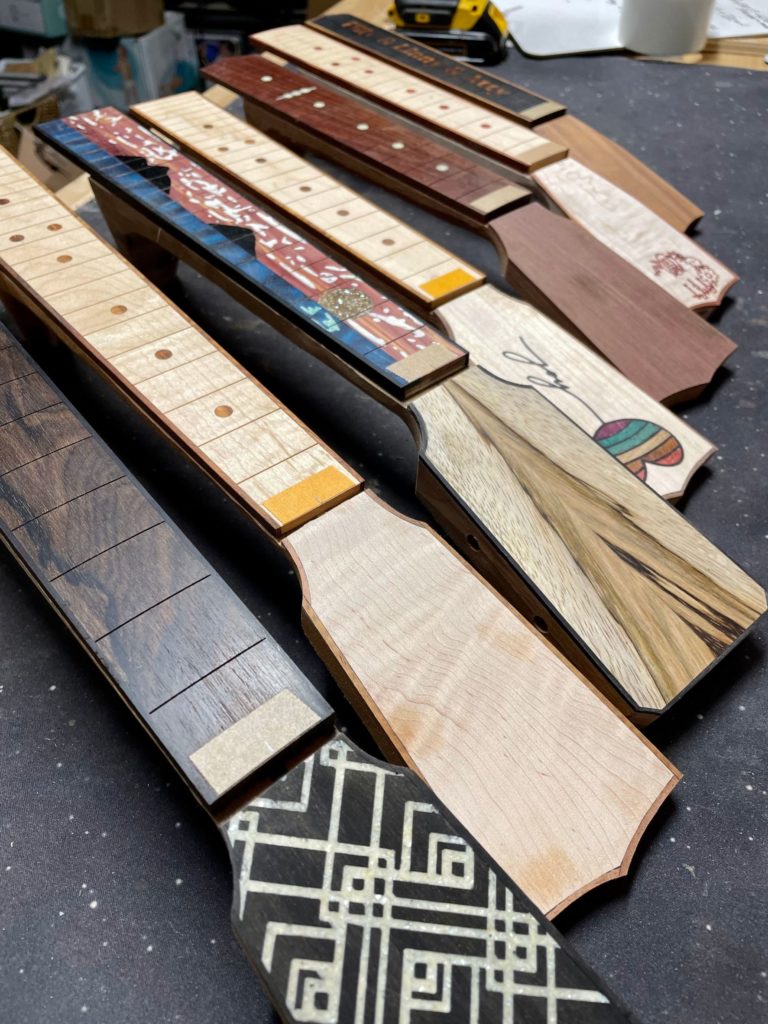
A lot of passion went to his ukulele and after he was done with his first uke, he already had new ideas for his next project. This inspired him, gave him joy and connected him to his heritage. This felt like the missing link in his life and Kawai wanted to keep building ukuleles. His partner EB supported him and gave him all the room to follow his new passion. Kawai and EB had two children, Kaipo and Nahele. EB watched the children during the pandemic, so Kawai could follow his newly found passion.
In early 2020, disaster struck as his life partner, EB suddenly passed away while pregnant with their third child. Now Kawai was on his own with his two kids and shortly after, his employer terminated his employment.. A lot of grief and stress followed, however the local and worldwide ukulele community lent him a lot of support. For instance, he had just ordered a supply of very expensive Hawaiian wood but in order to pay the rent and the bills, he reached out to return the wood to the supplier. Once they understood the reason for the return, they reimbursed him and told him to keep the wood to create a ukulele and share it with the people around him. The first ukuleles Kawai built were from his passion project and eventually gifts for friends and family.
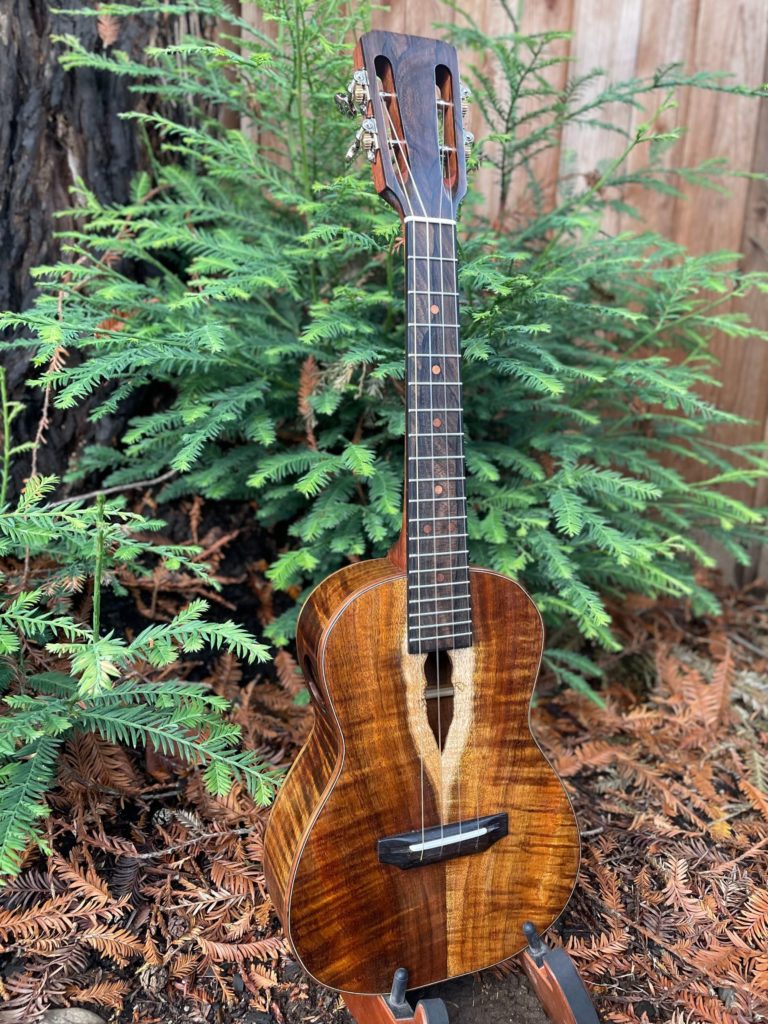
Without his partner and a job, he wanted to keep building ukuleles and as he learned a lot from the first dozen ukuleles he built, he could now start doing it professionally.
During the interview he showed me his garage with the basic tools he used to construct his first ukuleles. These were still there next to the new heavy machinery he bought over time to work efficiently and professionally. Currently he has created about 50 ukuleles and is working on ten of them simultaneously.
All his ukes are custom made in negotiation with his clients. Some have specific wishes, others leave the design to Kawai. At the time of this interview, he was working on multiple ukuleles with the same neck, inspired by the Hawaiian islands. After a ukulele is finished and it gets played by Kawai; he tells me it truly is a magical moment as his eyes shine describing the moment. When constructing a ukulele he never knows how it will sound finished.
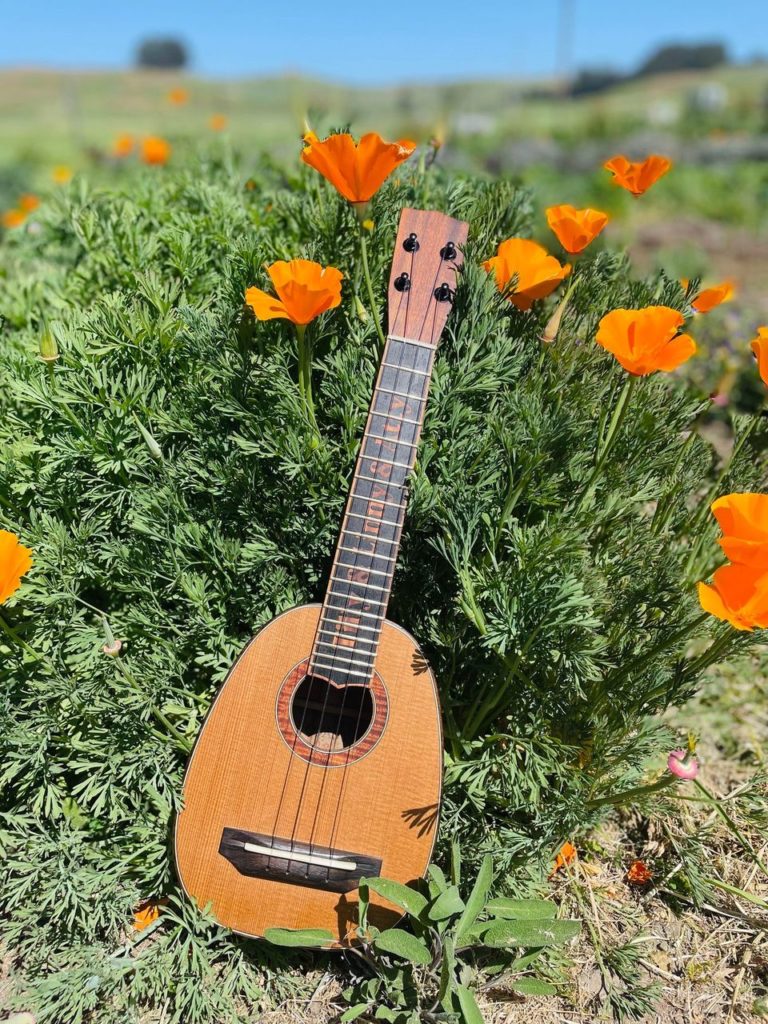
His favorite combination of woods is mango and spruce, but the Hawaiian Koa is a very popular wood. To all the UAS’ers reading this, Kawai has some advice: if you’re interested in custom ukuleles, you should buy one! Creating your own is costly and time consuming. The asking price of a Kawai custom build is currently around $1800 and his wait list is about a year long.Through Instagram, Kawai has shared his creations and has developed a strong following of about 2000 followers with a wonderful clientele, notwithstanding, the well known Southern Ukulele Store ordered a couple of ukuleles for their store.
In the future Kawai wants to keep making custom ukuleles for his brand Coast Ukulele. It’s his new home profession while watching the kids and homeschooling them. He isn’t looking to expand any further or hiring a lot of people to create a company. He wants to continue doing what he loves, building custom ukuleles with his heart, love and passion born during his life partnership with EB.
Follow Kawai’s journey and his creations on @coastukulele or coastukulele.com
Play the Ukulele
by The Cow and the Frog
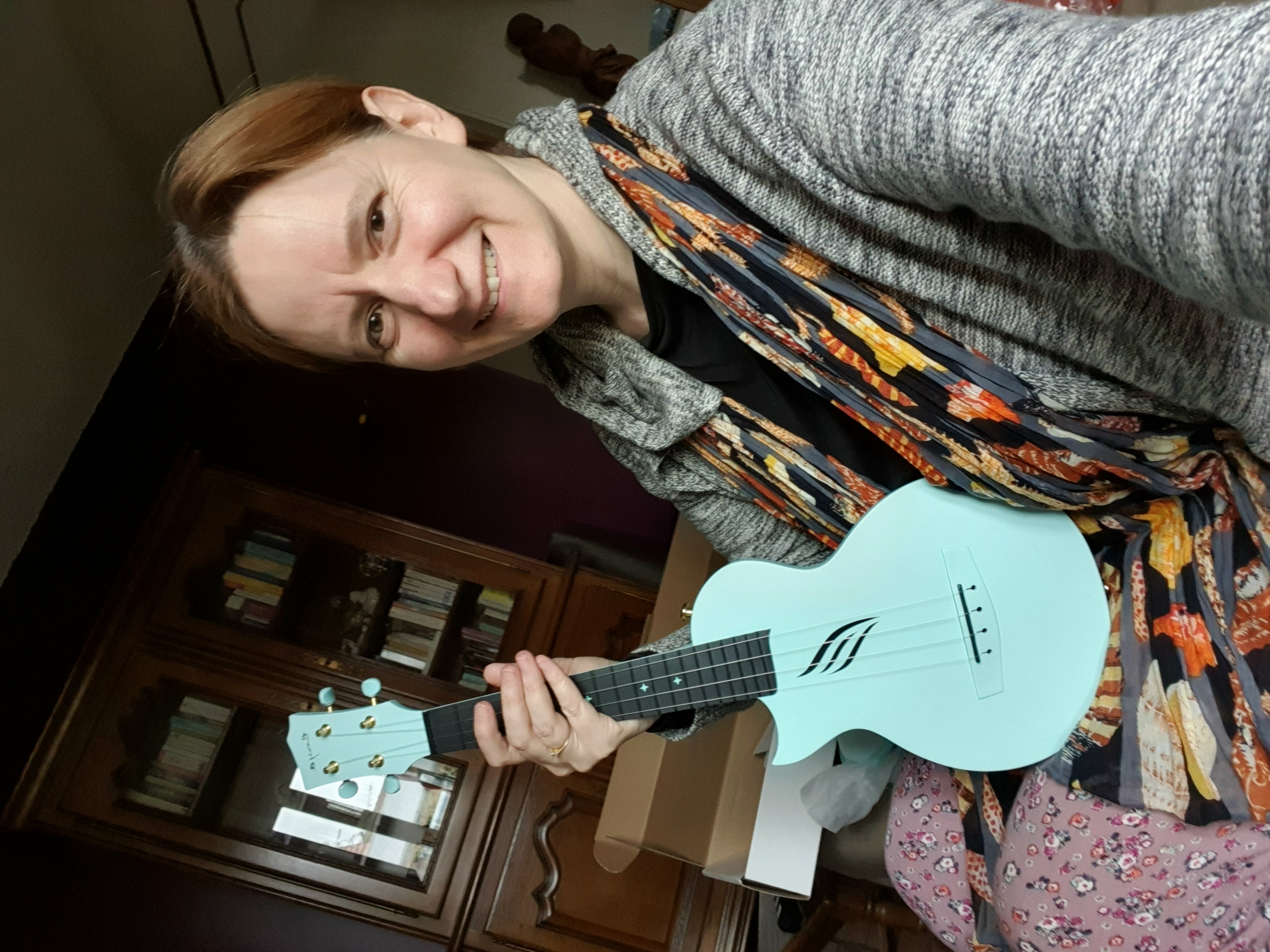
My story started with a bad, lingering tummy ache in the summer of 2021. I went to my doctor who told me it was constipation. It wasn’t.
Two days later, I collapsed at work and I was rushed to the hospital where I had a severe internal haemorrhage. After a week in the hospital, receiving blood transfusions and being examined, I was sent back home. I feel like an idiot as I was so wobbly and weak, nevertheless I tried to go back to work. I collapsed again, was taken to the hospital and my boss told me to stay home until they found the source of the problem. My brain was mush, and my body was not functioning correctly. Noone seemed to know what was wrong with me.
I was praying during this time, and was told “play the ukulele”. It seemed like an odd thing to do, but I followed through.
I ordered an Enya Nova. This purchase was based purely on the Amazon reviews, and the fact that it was turquoise! It arrived, and we looked at each other in bemusement!
I started searching the Internet for instruction, and came across a lovely young lady named Bernadette. I devoured her courses, challenges and joined her Facebook group, Ukelandia.
I lurked for a while, gawping at all the accomplished people there. I finally plucked up the courage to post something of my own. That was it… I was hooked! I’ve played several instruments in the past, but never one as satisfying and addictive as this.
Then came the news that changed my life. The examinations that I’d been going through showed an aggressive rare cancer that had also invaded the lymph nodes.
I opened my heart on Ukelandia, and received an incredible outpouring of love. I wept as messages of support came in from around the world. The Ukelandia family has stayed with me every step of this journey, and I can’t ever thank them enough for their prayers, positivity and uplifting messages.
You are incredible Ukelandia, I love you.
How ‘’My Battle’’ saved my life
by Pauline van de Haar

Once upon a time… I was depressed. It took me several years (I think more than 15 years) to recover from my chronic depression. Yes, I understand the confusion: ‘’chronic means not curable’’, right? You could say that, but luckily, I was able to recover with a lot of help from the mental health care services, my parents, my friends, and… myself.
What does this intro have to do with ukuleles, or music in general?
First of all, music is kind of a therapy on its own. We all know that, don’t we? Second of all, it’s amazing that there are people on this planet trained to use music in a therapeutic way for clients or patients who are having a hard time and dealing with all kinds of problems.
Let’s talk about musical therapy and how it was a life-saver for me.
The first time I got into musical therapy was in 2008. I was admitted to a psychiatric clinic for adolescents and every week we made music. We talked about the music we played, whether it sounded okay or less okay. At that time, I didn’t have a clue what I was doing: ‘’I play the recorder, guitar and I sing, why make music with people who don’t know anything about music?’’, is what I thought. Well, the whole point of musical therapy is that you don’t have to be ‘’good’’ with music. Music, or making sounds is a way to deal with your emotions etc. In 2008, my experience with musical therapy wasn’t so great. All I wanted, was to be happy again and be able to take my lessons at the music school.
It took me quite some time to make a giant climb in recovery. I will not ‘’bore you’’ with details in my recover-story. Some people talk a lot about stuff, for some people this helps and is enough to recover. Some people need a different kind of treatment, besides talking therapy. They need to do something with their hands or body. Making sounds and using your voice to make something that speaks for you is so beautiful.
In 2019, I was treated with musical therapy again. But this time not in a group; Just myself, my therapist and all these instruments. It was like a candy shop! I was allowed to try out every instrument in the room, feel what the vibrations and sounds did to me. The first session, I cried. I knew music meant everything to me, but the thing that changed is that I finally got the hope I could live again.
With my therapist, whom I saw once a week, I tried out several things and instruments. After a few sessions she thought that it could be nice for me to write music myself. At that time, I was already playing ukulele for about 6 years, but only songs written by other people. She helped me write my thoughts on paper, where I would want to go with my recovery journey. She gave me homework: play some chords and feel what’s good for your song. Two weeks later, I went to the session with a song. Not just chords, but also lyrics. ‘’My Battle’’ was born.
We worked on the song, recorded it with ukulele (me), voice (me) and piano (therapist). I kept listening to my own words over and over again. Later that year, I said farewell to my therapist, finally I lived again! I learned to use music to cope with the demons in my head.
A whole bunch of songs were written in the last two years. Most of them about self-compassion. Recently I started writing about other stuff as well. Grief, love, and being good enough.
This is my story, this is my battle. But now I can say: ‘’This was my battle’’.
Play It Forward
by Madeleine Roy
My ukulele journey seems very similar to many of yours in that the 2020 lockdowns pushed me to a dark lonely place and I was searching for a focus. I had just retired from my career in February and I was lost!
One day in May 2020, I noticed a small inexpensive soprano ukulele (Diamond Head) that my sons had purchased for me a number of years earlier when I was living in Ottawa, Canada. It was completely neglected as I just kept moving it with me wherever I relocated and I never even tried to play it.
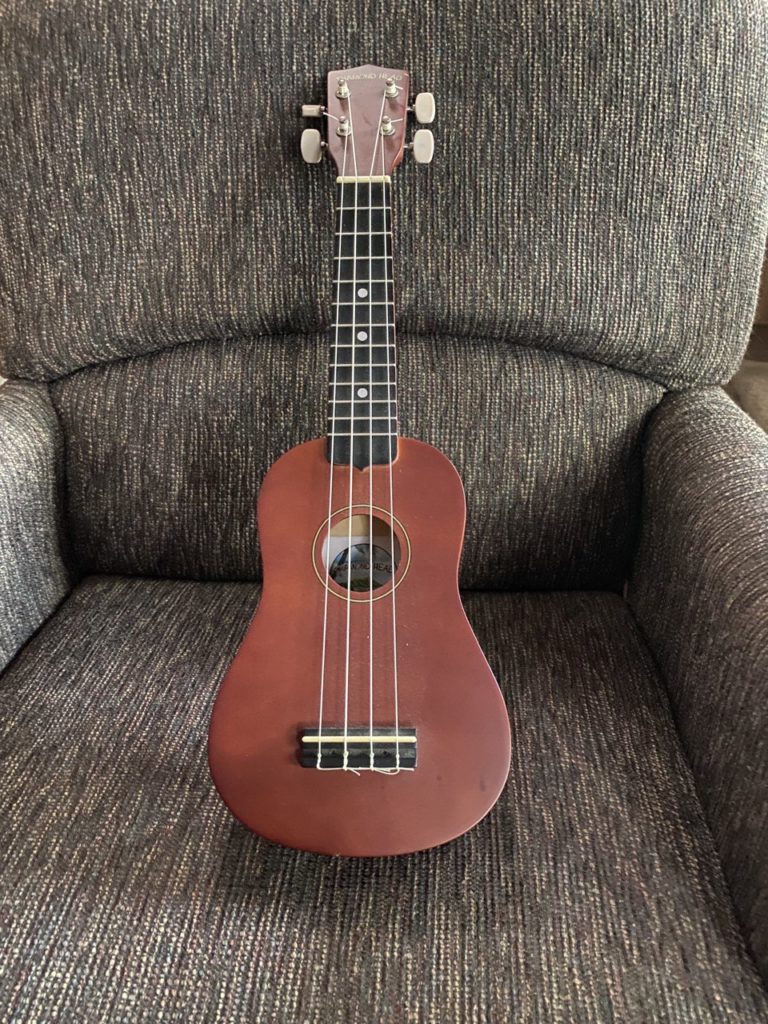
There it sat, just staring back at me, like it was saying…”If not now, when?”
I have never played a stringed instrument so this was going to be a challenge. Just what I needed!
Like so many of you, I combed YouTube looking for tutorials to learn this tiny little “guitar.” I learned bits and pieces from many artists, but it wasn’t until I discovered Bernadette, did my journey really begin and my love for this 4-string wonder evolved.
It was a matter of weeks and I started my UAS journey. I moved from a soprano to a tenor with a low g. Clearly I really didn’t know what I was doing.
I truly learned to play on the tenor as it took almost a year before I got Bernadette’s Signature Enya concert, which is my go-to most of the time. Shortly thereafter, I purchased 2 more concert ukuleles. I now have 7 ukuleles, a guitar and a guitarelele. (Small collection compared to some of you—Peg!)
I’m always looking for something new to add to my collection. Trouble is, the ones I want are so very expensive!
I joined Bernadette’s Patreon classes in late August 2020. This is when my sister came to visit me. She picked up the soprano and just started playing “Cucaracha” by ear! What? She’s never played a stringed instrument either but here she was shaming me in an instant.
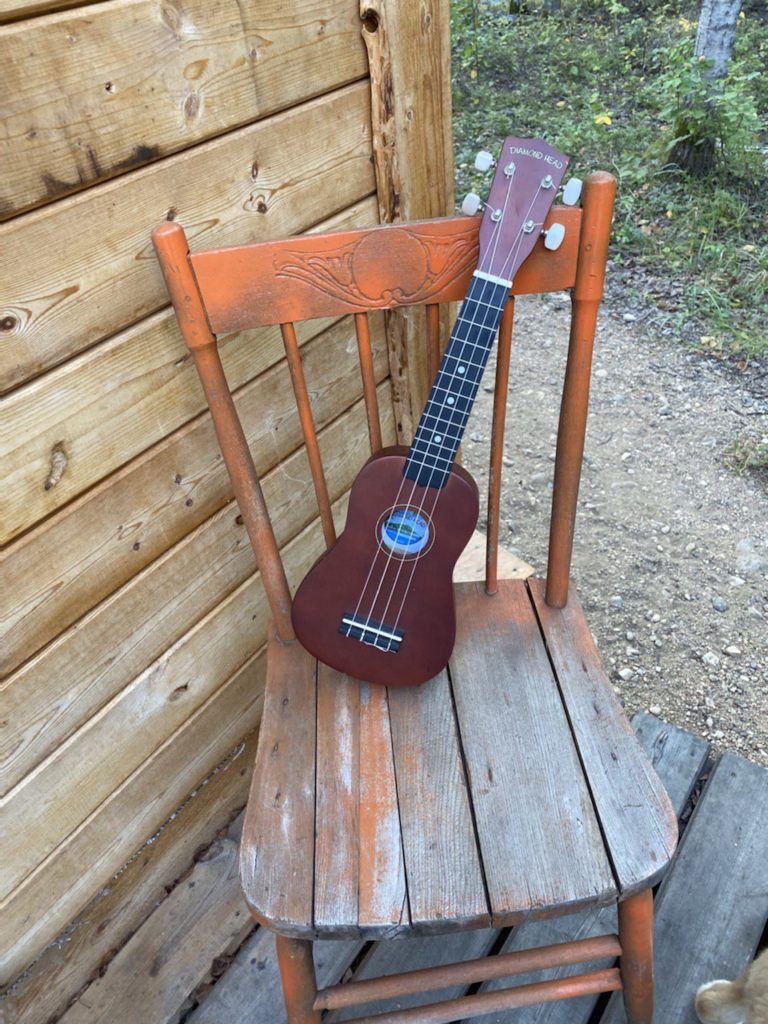
Obviously, I encouraged her and “played it forward” by giving her the Diamond Head soprano on her birthday in October. Last count, she now owns 3 ukuleles and
jams, with her husband when he plays the guitar. For Christmas, she and her husband played and sang me a Christmas carol as a recognition gift of starting their music journey together!
She has since bought her 6-year granddaughter a pink ukulele for her birthday. She’s “playing it forward” too!
I recently bought my 4-year old grandson (who lives with me) a soprano ukulele. He has shown an interest especially when I’m playing. He tells me I need to practice and so he can show me how to play. He then plucks at the strings to demonstrate. It’s adorable!
As I consider what I’ve shared so far, I realize I’ve been playing for 2 years now and still consider myself a beginner! It’s funny as both my son, Chad (a musician) and Bernadette always say, “Don’t compare yourself to others” and that is what I usually do and then want to quit or hide in the shadows.
Chad said to me, “Mom why are you doing this? Aren’t you having fun?”
I realized I love it, and yes I’m having fun! Most of all, I’m doing it for me and that’s what really matters. The very best part of all of this is my Ukelandia family!
I am blessed as I have friends from all over the world and I love you all!
You are my family!
Destination Aloha: in Search of the Perfect Uke
by Melinda Palacio
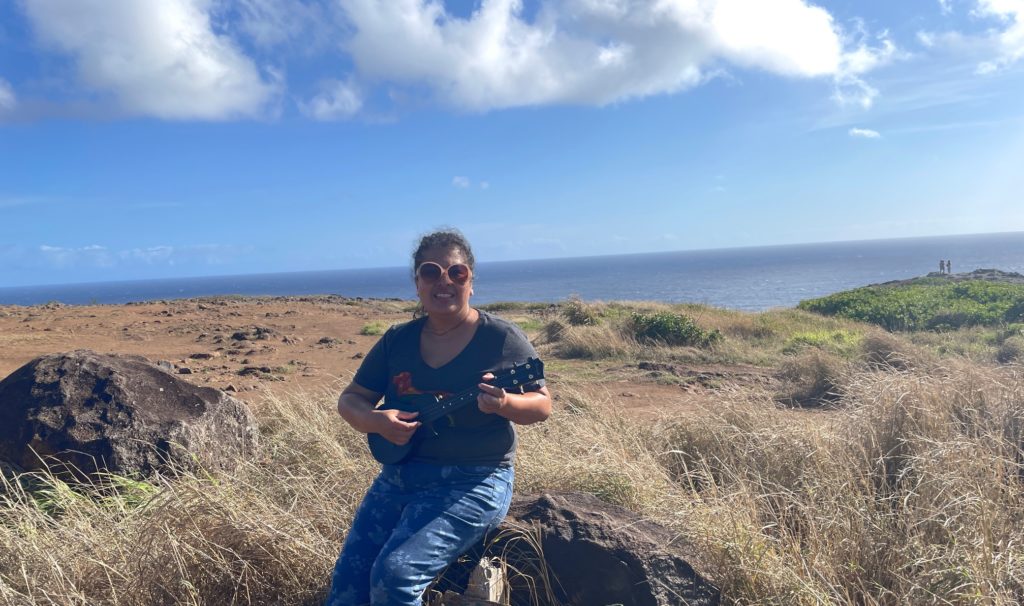
Would you plan the perfect vacation only to leave your uke behind (cue sad music in any minor key)? I guessed right; you would not. Last May, I took a girls’ trip to Maui. It was my friend’s birthday and she had planned the whole trip. All I had to do was show up. How could I resist such a fabulous invitation?
Before I left, I made sure my budget included a new uke. I’ve been devoting all my free time to studying the little instrument that brings me so much joy. When I realized I would be traveling to the birthplace of ukulele music, I knew I would be bringing one back. Although I knew I had every intention of finding a ukulele store in Maui, I didn’t take any chances of being without one and packed my black soprano Enya Nova. In the case, it fit snuggly at the bottom of my duffel bag with wheels, which I planned to stow overhead, having measured my bag back in California. On the plane, I fantasized that someone would see my Ukelandia t-shirt and whisk me away to the best ukulele shop on the island or that I would find a Hawaiian luthier under a shady palm tree, who would tell me they had the perfect uke for me. True, when I daydream, I don’t hold back.
Back to reality. My flight on Hawaiian Airlines landed on time and my friend had no trouble securing a rental car. I didn’t have to worry about my carry-on luggage or the soprano Enya Nova stuffed in my duffel bag. The Enya Nova is a great travel companion because it is made of carbon fiber so you don’t have to worry about heat or water, which made for fun photo opportunities by the pool and beach. In hindsight, it was smart of me to travel with my Enya, even though I would be bringing back a second ukulele. There’s only one drawback of the travel Enya and I bet you can’t guess what that is?
The one drawback is that it’s so great you may not return with it because you might give it away. When a friend asked me how many ukuleles I owned and I had a hard time counting them in my head, I realized I had a problem with UAS (ukulele acquisition syndrome). Let’s not get started on my guitar collection, a story for another time. I thought giving away a ukulele would be the best thing to do because I’d return with one instrument, instead of two. Not to mention the blue Enya Nova concert ukulele that waited for me in my car back in California. Although I miss the black Enya Nova soprano I named Johnny Cash, I brought home a souvenir from Hawaii and a locally made ukulele.
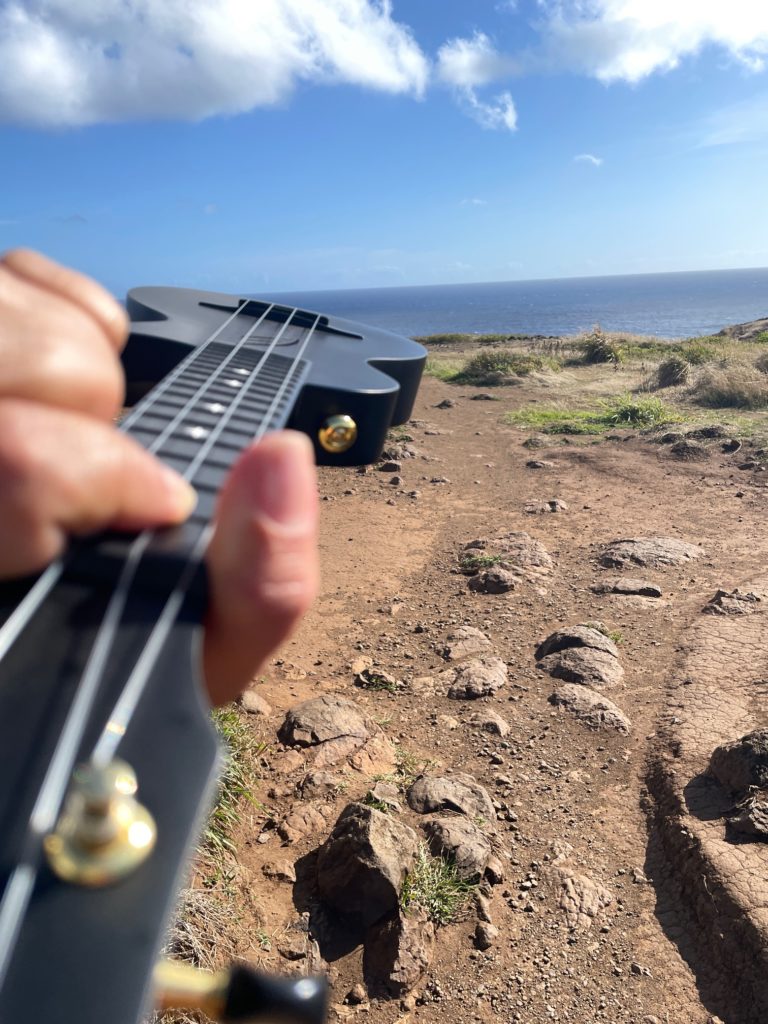
After choosing our rental car, we stopped at the first ukulele shop we spotted, Mele Ukulele, a modest building not far from the airport in Kihei. I chose my first pineapple mango: a pineapple shaped spalted mango concert ukulele. The matte finish shows off the natural beauty of the mango wood and the back is a little curly (a wave that is part of the design of the mango’s natural grain). Some ukulele experts argue that a matte finish allows for a better tone than a glossy finish. It’s a personal choice. While I love anything sparkly and shiny, the natural finish and rope binding of the Mele Ukulele spoke to me. The handmade uke has a tone that makes me return to it again and again. I also purchased a backpack style gig bag because I was sure there was no way I would check the uke on the plane. Also, my new mango pineapple ukulele was a tad bigger being a concert size, rather than the soprano Enya Nova that fit inside my duffel bag. I wasn’t about to stuff my new mango-pineapple into a bag or suitcase. If worse came to worse, I would check my duffel bag and purse and stuff important items such as my wallet and ticket into the pineapple gig bag.
Luckily, I didn’t have to check any baggage and everyone on Hawaiian Airlines respected my ukulele. The stewardess even had an overhead bin she reserved for travelers taking home a uke; there were three of us, which was surprising. I thought there would be more travelers taking home a new uke. After all, what better souvenir of the islands and the spirit of aloha than a handmade ukulele from Hawaii?
Follow my ukulele travel journeys on IG at ukenmermaid.
